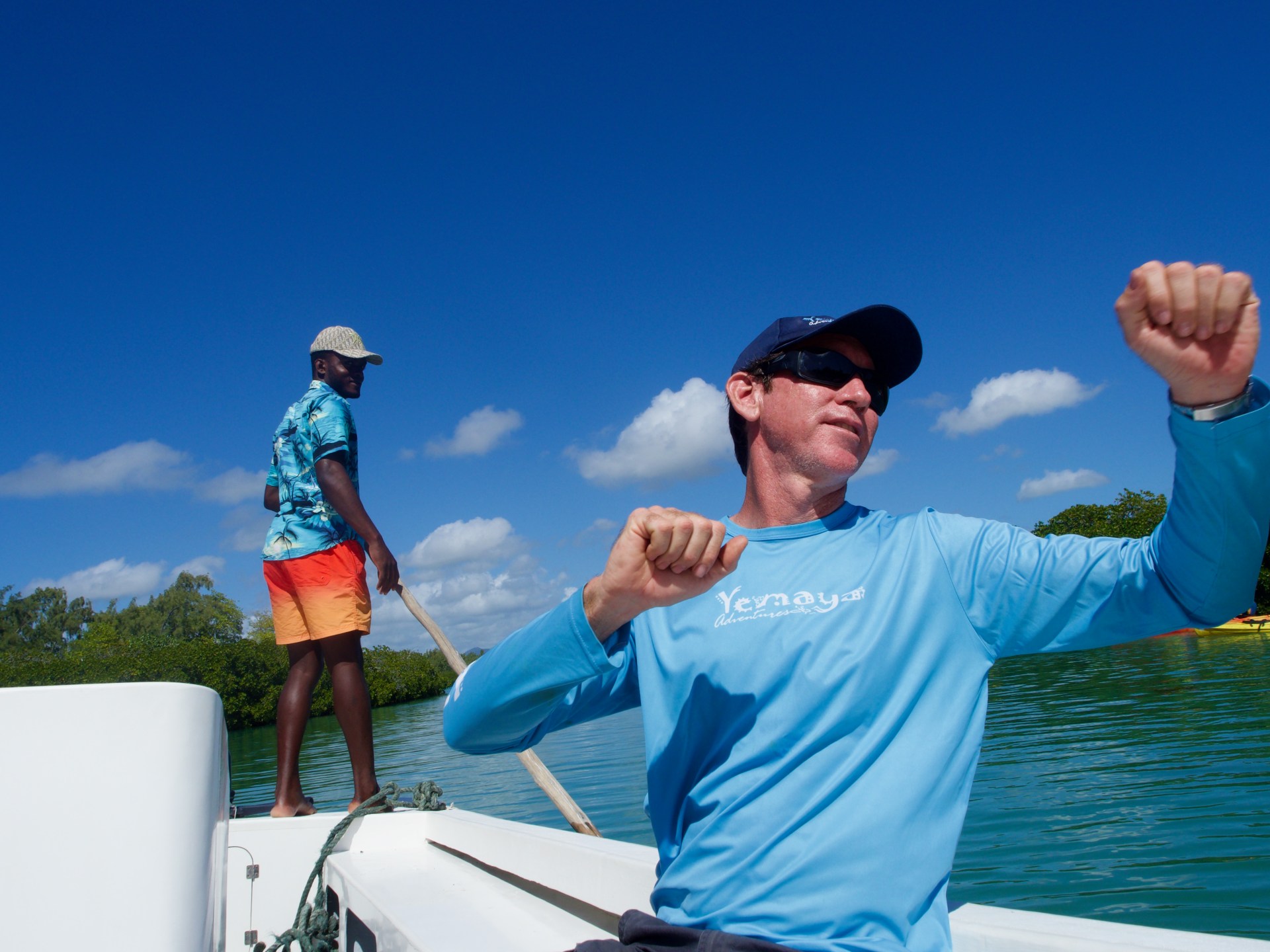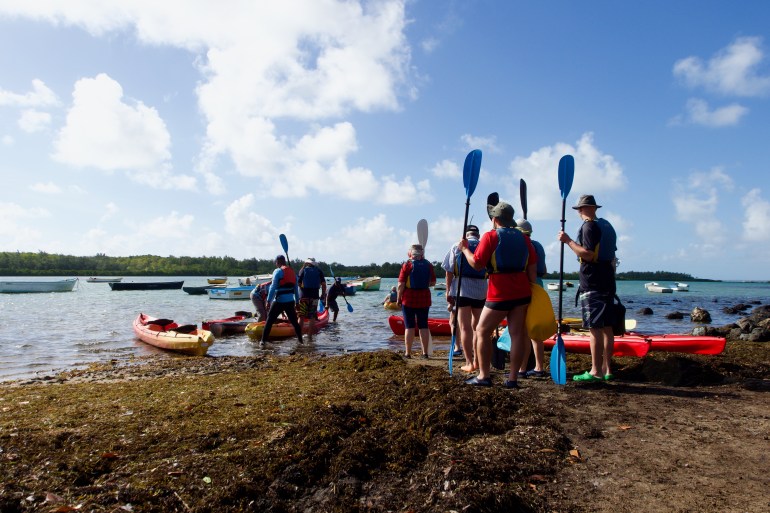
Amber Island, Mauritius – Apparently the last dodo was spotted here. But today the Île d’Ambre, an island off the northeast coast of Mauritius lined with bright green mangroves, stands not as a symbol of extinction but of survival.
As tour guide Patrick Haberland explains, until the mid-1990s, large areas of mangroves were destroyed to produce firewood or to clear the way for boat routes and hotel construction projects.
Deforestation of mangroves is now prohibited by law. As part of a national nature conservation initiative, places such as the Île d’Ambre have now been restored. Today it is a national park protected by the government’s forest department.
Having escaped extinction, the trees are now vital to the nation’s survival. Its dense, tough roots, along with coral reefs and seagrass beds, are among the island’s main lines of defense against rising tides that erode and engulf its silvery beaches 20 metres the coastline in the last decade.
It’s a predicament that weighs heavily on Haberland, who runs Yemaya Adventures, a small business that takes tourists on canoe trips through the mangroves. He is one of a growing number of locals pushing for a “back to nature” approach to tourism. “The environment is our basis of life. If we don’t respect it, we won’t have jobs,” he says.
“Killing the Golden Goose”
As the number of tourists, which increased by almost 60 percent in the first half of the year, continues to grow, the island finds itself in a quandary. How can it sustain an industry that has not only strained its fragile ecosystems but also contributed to global climate change, which in turn is bleaching its reefs and causing sea levels to rise by an alarming 5.6mm per year?
“It kills the golden goose and destroys the environment,” says activist Yan Hookoomsing of the nonprofit Mru2025. As Hookoomsing points out, the hotel industry is still expanding. As early as 1997, the government set a “green ceiling” of 9,000 hotel rooms for the entire country in the “Vision 2020” plan for the industry. Recently, Tourism Minister Steven Obeegadoo announced the construction of 19 new hotel buildings, bringing the total to nearly 16,000.
With tourism numbers on the rise, Hookoomsing and his partner Carina Gounden are committed to fencing the country’s southern coast, proposing a geopark on the stunning stretch of coastline that features sand dunes, sea cliffs, lava caves, pools, waterfalls, etc. Estuaries, lagoons and open sea.
The Green Lung project, currently awaiting government approval, would be a logical step for a country seeking to balance its dependence on tourism through sustainable land use policies – only four percent of the native forest remains, the result of the expanded Sugar cane cultivation in the middle of the 19th century.
Hookoomsing and Gounden fell in love while campaigning to evict hotel developers from Pomponette, a public beach in the south – a battle they ultimately won in 2020. As with so many other hotel projects, it would have resulted in locals being excluded from their shores. “We need to think about how we share these spaces,” says Gounden. “You can’t just tell the public to move away.”
“Mauritians feel like second-class citizens,” she adds. “They feel like they are losing something that made them happy: the beauty of their country. This impacts the way we welcome tourists.”
No more greenwashing
“The baseline of what is acceptable is changing,” says Vikash Tatayah, conservation director at the Mauritian Wildlife Foundation.
He hopes that tourists will drive the change towards sustainability. Currently, the foundation is developing niche ecotourism activities that allow visitors to spend time with local researchers. Eco-volunteering is another potential growth area that allows tourists to get involved in conservation.
Nature is one of the island’s main attractions, he says. “People come from all over the world to see the kestrels and pink doves. Some come to see rare reptiles. Others come for rare plants like the tambalacoque (dodo tree) or mandrinette hibiscus.”

“One thing that hotels and companies will no longer be able to do in the future is greenwashing – we have eliminated all of our plastic cups, so we are ecological,” he adds. “Tourists want to know the environmental policies of the countries they visit. They want to know that hotels are committed to conservation and that staff are employed on site.”
The luxury market is aware of the changing mood and is also getting involved. Local group Rogers has redeveloped the former Bel-Ombre sugar plantation and revitalized the area as a kind of ecotourism mecca. Its three hotels offer carbon-neutral packages that integrate solar energy and water reuse initiatives and offset emissions through Africa’s Aera carbon credit program.
The hotels are located in a buffer zone in the UNESCO-recognized Black River Gorges National Park-Bel Ombre Biosphere Reserve. Covering more than 8,500 hectares (32.8 square miles), the reserve is considered a model of environmentally friendly development, bringing back endemic trees such as the black ebony and providing a home to rare native species such as the Mauritian flying fox and pink pigeon.
Just change
Change seems inevitable, but it must be equitable if it is to be truly sustainable, analysts say.
“We must replace sea, sand and sun with restoration, recycling and respect,” says oceanographer Vassen Kauppaymuthoo. “The environment can be used as a transformative tool for tourism. If ecotourism is presented as an opportunity that people can get involved in and that will give them back their confidence, then we can ignite that spark.”
To some extent, he believes this shift will require a long, hard think about the country’s identity, reversing recent trends that have seen the country copy glitzy destinations like Dubai and Singapore. Failure to do so properly could bankrupt the sector, which accounts for a quarter of gross domestic product (GDP), he says.
But if there’s one thing this small nation excels at, it’s survival. When Mauritius took its first steps as an independent state in 1968, growing only sugarcane monocultures, failure was predicted. In the 90s it was considered a role model for the African continent.
“At the end of the day, we are resilient,” says Kauppaymuthoo. “We are used to radical changes.”






Recent Comments